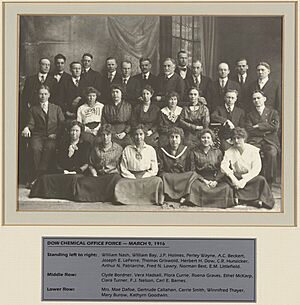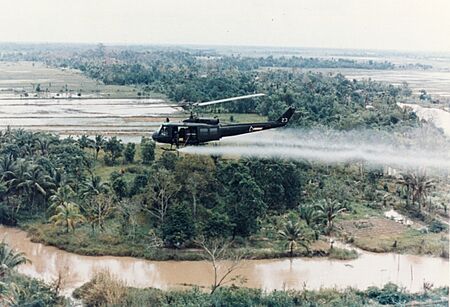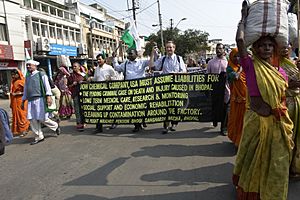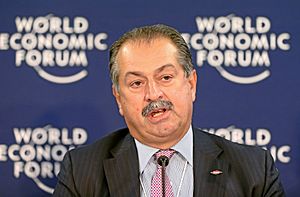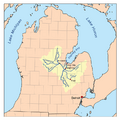Dow Chemical Company facts for kids
 |
|
| Public | |
| Traded as | DJIA component (2019-2024) |
| Industry | Chemicals |
| Founded | 1897 (original company) 1 April 2019 (current iteration) |
| Founder | Herbert Henry Dow |
| Headquarters | Midland, Michigan, U.S. |
|
Area served
|
Worldwide |
|
Key people
|
|
| Products | Chemicals, plastics, performance chemicals, catalysts, coatings, hydrocarbon exploration |
| Revenue | |
|
Operating income
|
|
| Total assets | |
| Total equity | |
|
Number of employees
|
c. 36,000 (2024) |
| Subsidiaries |
|
Dow Inc. is a very large American company that makes chemicals and plastics. It is a multinational corporation, which means it does business all over the world. Its main office is in Midland, Michigan. In 2021, Dow was one of the three biggest chemical makers in the world.
The company has about 36,000 employees and works in 160 countries. Dow is known as the "chemical companies' chemical company." This is because it usually sells its products to other companies, not directly to people. These other companies then use Dow's chemicals to make things we use every day.
In 2017, Dow merged with another big chemical company, DuPont, to form a new company called DowDuPont. But in 2019, they split into three separate companies. One of these new companies took the Dow name and focuses on making materials and plastics.
Contents
History
How Dow Got Started
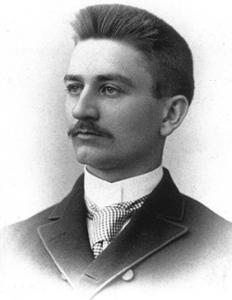
Dow was started in 1897 by a chemist named Herbert Henry Dow. He found a new way to get bromine, a useful chemical, from salty water called brine that was deep underground in Michigan. At first, the company only sold bleach and potassium bromide.
Soon, other companies tried to compete with Dow by selling bleach for very low prices. Dow lowered its prices too and started making many different kinds of products. This helped the company survive and grow. Within 20 years, Dow was making chemicals for farming, chlorine, dyes, and magnesium metal.
During World War I, the United States could not get many chemicals from Germany. Dow stepped in to make these materials for the war. The company produced magnesium for flares, chemicals for explosives, and bromine for medicines and tear gas. By 1918, most of what Dow made was for the war. It was during this time that Dow created its famous diamond-shaped logo.
Growing and Changing
After the war, Dow kept working with magnesium. They developed special pistons for car engines that made cars faster and more fuel-efficient. A car with Dow's pistons even won the Indianapolis 500 race in 1921.
When Herbert H. Dow passed away in 1930, his son Willard took over. Even during the Great Depression, a time when many businesses struggled, Dow kept investing in new ideas. In the 1930s, Dow started making plastics like ethylcellulose and polystyrene. This would become a huge part of their business.
World War II
During World War II, Dow became very important for the war effort. The company built a large plant in Freeport, Texas, to get magnesium from seawater. Magnesium was needed to make lightweight parts for airplanes. Dow's plants made most of the magnesium for the United States during the war.
The war also created a need for synthetic rubber because natural rubber was hard to get. Dow was the only company in the U.S. that made styrene, a key ingredient for synthetic rubber. Dow helped the government produce the rubber needed for the military.
Dow also made many plastics for the war. A plastic called ETHOCEL™ was used for things like telephone parts and goggles. Foamed polystyrene, which later became famous as STYROFOAM™, was used to help lifeboats float. Another plastic, SARAN™, was used to make screens to protect soldiers from insects in the jungle. Later, it was used to make Saran Wrap™ for kitchens.
In 1943, Dow and Corning Glass Works created a new company called Dow Corning. They worked together to make silicone products for the military. One of their first products helped airplanes fly at high altitudes.
After the War
After the war, the company continued to grow and expand. Under president Leland Doan, Dow started making more products for regular consumers. As more people bought homes, they needed more household products. Dow began selling things like Saran Wrap directly to customers in 1953.
The company also expanded around the world. It opened its first factory outside of North America in Japan in 1952. Soon, Dow had factories and offices on every continent.
Controversial History
Throughout its history, Dow has been involved in several major controversies.
Nuclear Facility Management
From 1951 to 1975, Dow managed the Rocky Flats Plant near Denver, Colorado. This factory made plutonium triggers, which are parts for hydrogen bombs. There were problems at the plant, including fires and leaks of radioactive material that contaminated the area. Years later, Dow and another company that ran the plant settled a lawsuit with nearby residents for $375 million.
Vietnam War Chemicals
During the Vietnam War, Dow was one of the companies that made napalm for the U.S. military. Napalm is a jelly-like gasoline used in bombs. Many people protested against the use of napalm, but Dow continued to make it until 1969, saying it had a duty to the government.
Dow also made Agent Orange, a powerful chemical used to kill plants and clear forests during the war. This chemical contained a harmful substance called dioxin. After the war, many soldiers and Vietnamese people suffered serious health problems. Lawsuits were filed against Dow and other companies, but they were dismissed.
Bhopal Gas Tragedy
In 1984, a terrible accident happened at a pesticide plant in Bhopal, India. The plant was owned by Union Carbide India Ltd., a part of the Union Carbide company. A cloud of poisonous gas leaked from the plant and spread through the city, killing thousands of people and injuring hundreds of thousands more.
In 2001, Dow bought Union Carbide. Activists and survivors of the disaster believe Dow should be responsible for cleaning up the contaminated site and helping the victims. The site is now controlled by the Indian government.
Dioxin in Michigan
The Tittabawassee River in Michigan runs very close to Dow's main plant in Midland. In 2006, high levels of dioxin, a cancer-causing chemical, were found in the river's soil. People who ate a lot of fish from the river had slightly higher levels of dioxin in their blood. Dow worked with the government to clean up the contaminated areas of the river.
Mergers and Changes
In the 1990s and 2000s, Dow went through many changes. It bought and sold different parts of its business to focus on what it does best.
Union Carbide Merger
In 1999, Dow bought the Union Carbide Corp. for $9.3 billion. This made Dow the second-largest chemical company in the world at the time. The purchase was controversial because it meant Dow also took on the responsibilities related to the Bhopal disaster.
Rohm and Haas Purchase
In 2008, Dow bought Rohm and Haas, a company that makes specialty chemicals. These are chemicals with special uses that can be sold for higher prices. This was a big step for Dow to move away from making basic chemicals and toward more advanced products.
Merger with DuPont
On December 11, 2015, Dow and DuPont announced they would merge into one giant company called DowDuPont. The plan was to then split this huge company into three smaller, more focused companies.
The split happened in 2019. The three new companies focus on:
- Agriculture (now called Corteva)
- Specialty Products (the new DuPont)
- Materials Science (the new Dow Inc.)
The new Dow Inc. became the parent company of The Dow Chemical Company.
What Dow Makes Today
Dow is a major producer of plastics, chemicals, and other materials that are used in thousands of products.
- Performance Plastics: This is Dow's biggest business. It includes plastics like polyethylene and polystyrene (used to make Styrofoam). These are used in cars, buildings, and packaging.
- Performance Chemicals: These chemicals are used for things like cleaning water, making medicines, and in electronics.
- Basic Plastics and Chemicals: These are the building blocks for many other products. They include chemicals like chlorine and materials for making plastic bottles and bags.
- Agricultural Sciences: Until 2019, Dow made pesticides and seeds for genetically modified plants. This part of the business was spun off into the new company, Corteva.
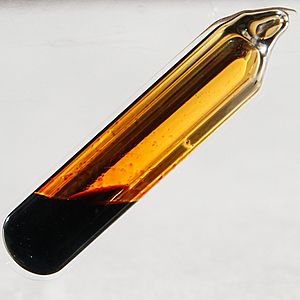
Environmental Actions
Dow has taken steps to improve its environmental record. The company has won awards for saving energy. Between 1995 and 2005, it reduced the amount of energy it used to make its products by 22%.
The company has also worked to reduce its carbon footprint. In 2020, Dow reported its total CO2 emissions and announced a plan to reduce them by 15% by the year 2030.
However, the U.S. Environmental Protection Agency (EPA) has identified Dow as being partly responsible for 96 Superfund toxic waste sites across the country. These are areas that are so polluted they need special, long-term cleanup.
Images for kids
See also
 In Spanish: Dow Chemical Company para niños
In Spanish: Dow Chemical Company para niños


